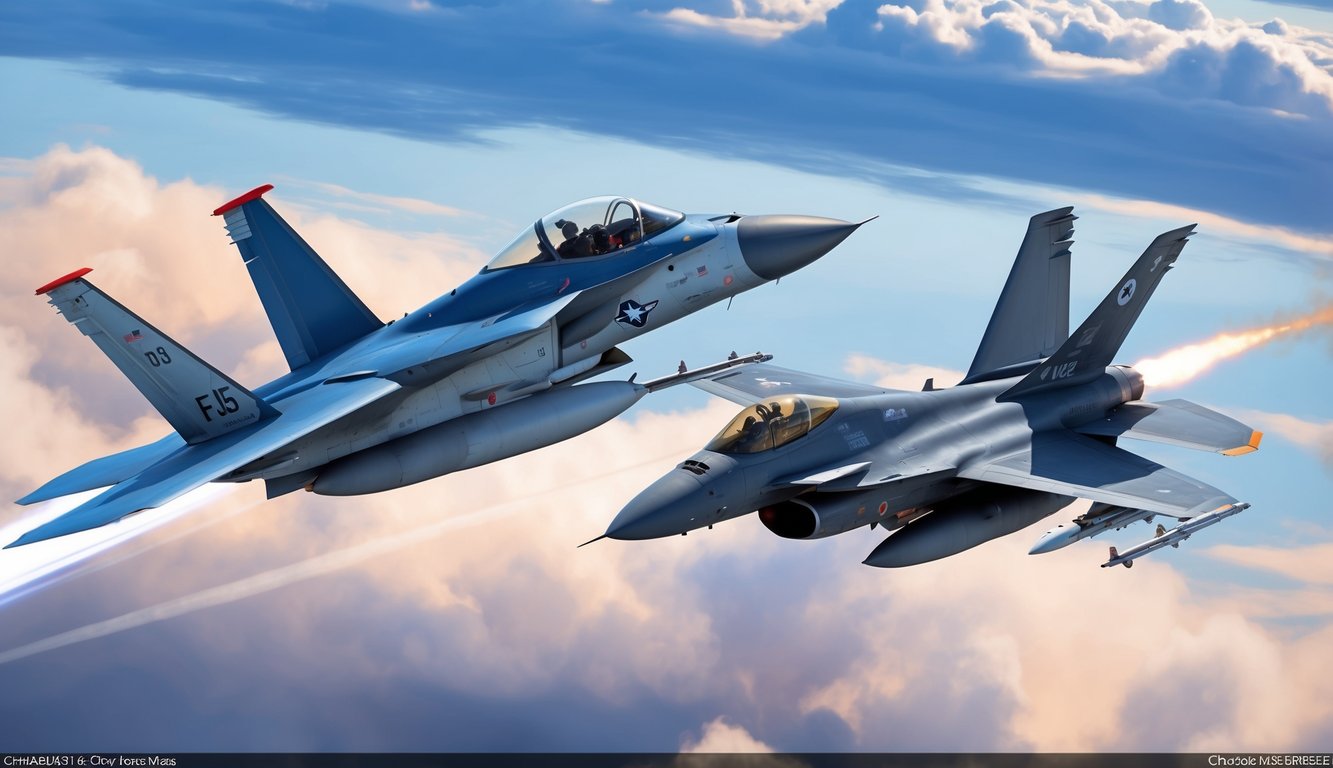The F-15 Eagle and F-16 Fighting Falcon are two legendary American fighter jets that have ruled the skies for years.
Despite both being powerful air superiority fighters, they showcase notable differences in design, abilities, and operational roles. The F-15 is a larger, more powerful, and more expensive twin-engine fighter, whereas the F-16 is a smaller, more agile, and cost-effective single-engine aircraft.
When comparing these two jets, the F-15 features unique twin tails and a bulkier profile, in contrast to the F-16’s streamlined single-tail design.
The F-15 was specifically engineered for long-range air-to-air combat, boasting potent engines that can achieve speeds of up to Mach 2.5.
The F-16, on the other hand, was crafted as a nimble multirole fighter proficient in both air-to-air and air-to-ground operations.
Both jets have demonstrated their capabilities in various combat scenarios worldwide.
The F-15 has a remarkable air-to-air combat record, while the F-16’s adaptability has made it a favored choice among numerous air forces globally.
As you delve deeper into the comparison of these two aircraft, you’ll uncover how their unique features have influenced contemporary air warfare and continue to shape fighter design.
Key Takeaways
- F-15 is larger and more powerful, while F-16 is lighter and more agile
- Both jets have demonstrated combat effectiveness in distinct roles
- F-15 is superior in air superiority; F-16 excels in multirole operations
Historical Background and Development
The origins of the F-15 Eagle and F-16 Fighting Falcon can be traced back to specific military needs during the Cold War period.
Both aircraft have been pivotal in defining modern air combat capabilities for the U.S. Air Force and NATO allies.
Origins of the F-15 Eagle
The F-15 Eagle was developed as a response to the U.S. Air Force’s demand for a dedicated air superiority fighter.
Lessons from the Vietnam War highlighted the need for a fast, powerful, and highly maneuverable aircraft.
In 1967, McDonnell Douglas (now part of Boeing) secured the contract to design the F-15, incorporating twin engines for exceptional speed and climb ability.
Its first flight occurred in 1972, and it entered military service in 1976.
The focus during the F-15’s development was to achieve complete air dominance.
It features advanced radar systems and can carry a substantial payload, making it a formidable choice in air-to-air combat environments.
Genesis of the F-16 Fighting Falcon
The F-16’s inception began as part of the Lightweight Fighter program in the early 1970s, aiming to create a smaller, more agile complement to the F-15 that could efficiently perform multiple roles.
The design of the F-16, developed by General Dynamics (now Lockheed Martin), emphasized maneuverability and cost-efficiency.
It first flew in 1974 and was introduced into service in 1978.
This multirole fighter was engineered to excel in both air-to-air and air-to-ground missions.
Its single-engine design and advanced fly-by-wire technology provide remarkable agility.
The aircraft quickly became a favorite among NATO allies, solidifying its legacy in aviation.
Design Philosophy and Structure

The F-15 Eagle and F-16 Fighting Falcon illustrate different design philosophies that dictate their roles and capabilities in aerial combat.
Significant differences in size, engine configuration, and structural design are evident.
F-15 Eagle’s Robust Design
The F-15 Eagle features a sturdier and larger construction.
Its twin-engine configuration delivers vast thrust, enabling impressive acceleration and climbing rates.
The swept wings and twin-tail design enhance stability and maneuverability at high speeds.
Its spacious airframe supports a large fuel capacity and considerable payload, offering extended range and operational endurance.
The cockpit design also ensures excellent visibility, which enhances situational awareness during missions.
- Wingspan: Approximately 43 feet
- Twin-tail configuration
- Large and robust airframe
F-16 Fighting Falcon’s Agile Build
Conversely, the F-16 Fighting Falcon features a compact, lightweight layout.
Its single-engine configuration contributes to cost-effectiveness and agility.
The aircraft’s streamlined single-tail profile makes it more challenging to detect on radar.
The fly-by-wire system enhances precision in control inputs, giving an advantage in close dogfights.
The F-16’s smaller design amplifies its maneuverability and versatility across different combat situations.
- Wingspan: About 33 feet
- Single-tail design
- Compact, lightweight airframe
The F-16’s cockpit has a unique bubble canopy, providing you with unobstructed 360-degree visibility, significantly improving tracking capabilities during aerial engagements.
Performance Metrics
The F-15 Eagle and F-16 Fighting Falcon each excel in different performance domains.
The F-15 stands out in terms of speed and altitude capabilities, while the F-16 impresses with its agility and maneuverability.
Speed and Altitude
In terms of pure speed, the F-15 takes the forefront, capable of achieving a maximum speed of Mach 2.5+ at high altitudes, while the F-16 reaches Mach 2.
The Eagle also has a superior service ceiling, reaching approximately 65,000 feet compared to the Falcon’s 50,000 feet.
For climb rates, the F-15 again leads, soaring from sea level to 30,000 feet in a mere 60 seconds.
Though impressive, the F-16 takes longer to reach similar altitudes.
The F-15’s performance provides a distinct advantage for high-altitude intercepts.
Its twin-engine design enables sustained operations at extreme altitudes, positioning it as an ideal candidate for air superiority missions.
Power and Maneuverability
While the F-15 excels in speed and altitude, the F-16 shines in maneuverability.
Its higher thrust-to-weight ratio allows for rapid acceleration and sharp turns.
The F-16’s fly-by-wire controls enhance its responsiveness, making it a formidable competitor in close-quarter combat or dogfighting situations.
This agility allows it to execute high-G maneuvers more effortlessly, marking it as a significant adversary in air-to-air confrontations.
Although the F-15 is less nimble, it compensates with significant power.
Its twin engines offer excellent acceleration, even at high altitudes, maintaining energy in vertical maneuvers—an essential advantage during certain combat scenarios.
Armaments and Avionics
The F-15 Eagle and F-16 Fighting Falcon are equipped with impressive arsenals and advanced avionics systems.
Each aircraft excels in different aspects; the F-15 is known for its firepower, while the F-16 is recognized for its precision strike abilities.
F-15 Eagle’s Superior Firepower
The F-15 Eagle is armed with substantial weaponry, carrying up to eight air-to-air missiles, including AIM-9 Sidewinders and AIM-120 AMRAAMs.
Its M61 Vulcan 20mm cannon delivers impressive firepower with 940 rounds.
In air-to-ground operations, you can equip it with various bombs and missiles.
The F-15E Strike Eagle variant can carry a total of up to 23,000 pounds of ordnance.
The advanced avionics suite on the Eagle includes sophisticated radar systems, electronic warfare capabilities, and helmet-mounted cueing systems.
These features provide exceptional situational awareness during air combat.
F-16 Fighting Falcon’s Precision Strike
While the F-16 has a smaller payload, it maximizes its capabilities effectively.
It can carry up to six air-to-air missiles and has an M61 Vulcan cannon with 511 rounds.
Its precision strike functionality is particularly strong in air-to-ground operations.
The Falcon can deploy smart bombs, guided missiles, and cluster munitions with remarkable accuracy.
The advanced fly-by-wire control system allows for exceptional maneuverability and enhances efficiency in air combat.
Its modern cockpit includes heads-up displays and multi-function instruments.
You’ll appreciate the LANTIRN targeting pod for night missions and the capability for JDAM GPS-guided bomb strikes.
These technologies ensure the F-16 remains a versatile multirole fighter.
Operational History and Combat Usage

The F-15 Eagle and F-16 Fighting Falcon have established strong reputations in numerous conflicts over the years, with impressive combat records showcasing their prowess in air superiority and multirole operations.
F-15 Eagle in Air Superiority Missions
The F-15 Eagle made its combat debut in the 1982 Lebanon War, where it successfully established air superiority against Syrian forces.
Its extraordinary air-to-air kill ratio—over 100 victories and zero defeats—attests to its effectiveness.
During the 1991 Gulf War, F-15s were crucial in dominating Iraqi air defenses.
The Eagle’s long-range radar capabilities and powerful engines ensured that enemy aircraft were intercepted before posing a risk.
The F-15’s combat radius allows for extensive operations in enemy territory, making it a formidable resource in air superiority missions.
Its all-weather capability enables deployment across diverse conditions, maintaining air dominance.
F-16 Fighting Falcon in Versatile Roles
The F-16 has participated in numerous conflicts, highlighting its versatility in both air-to-air and air-to-ground roles.
It demonstrated effectiveness during significant operations, such as the 1991 Gulf War, in Afghanistan, and during the 2003 Iraq invasion.
Its superior stability and agile design establish the F-16 as a potent dogfighter.
In hand-to-hand combat, its capacity to outmaneuver larger aircraft is evident.
As a multirole fighter, the F-16 has displayed its strength in precision strike missions.
Its adaptability enables configurations for a variety of operations, ranging from air defense to close air support.
Though the F-16’s combat radius is shorter than that of the F-15, it provides enough range for most missions.
Its performance in diverse combat situations cements its value in modern air forces.
Technological Advancements
The F-15 and F-16 have seen significant technological enhancements over the years to maintain their effectiveness in combat.
These upgrades have improved their avionics, weapon systems, and overall capabilities.
F-15’s Avionic Upgrades
The F-15 has received notable upgrades in its avionics.
The introduction of the Advanced Radar system enhances situational awareness and target detection.
Moreover, Boeing Defense has implemented an advanced mission computer for quicker data processing and enhanced weapon guidance.
Modernized cockpits now feature large touchscreen displays that provide clearer information presentation, customizable to suit mission objectives.
Additionally, the Pratt & Whitney engines have been upgraded for better fuel efficiency and thrust, enabling longer and faster flights than previously possible.
F-16’s Evolution in Systems
The F-16 has also received considerable technological advancements in its avionics.
Recent versions now come equipped with an Active Electronically Scanned Array (AESA) radar, providing enhanced detection and tracking capabilities.
The new Helmet Mounted Display system boosts situational awareness, enabling pilots to target enemies just by looking at them—transforming close combat capabilities.
Software updates on the F-16 have included major improvements, with advanced data fusion technologies integrating sensor information to offer a comprehensive operational view.
AI-driven decision-making support aids pilots in critical moments.
Variants and Modernization
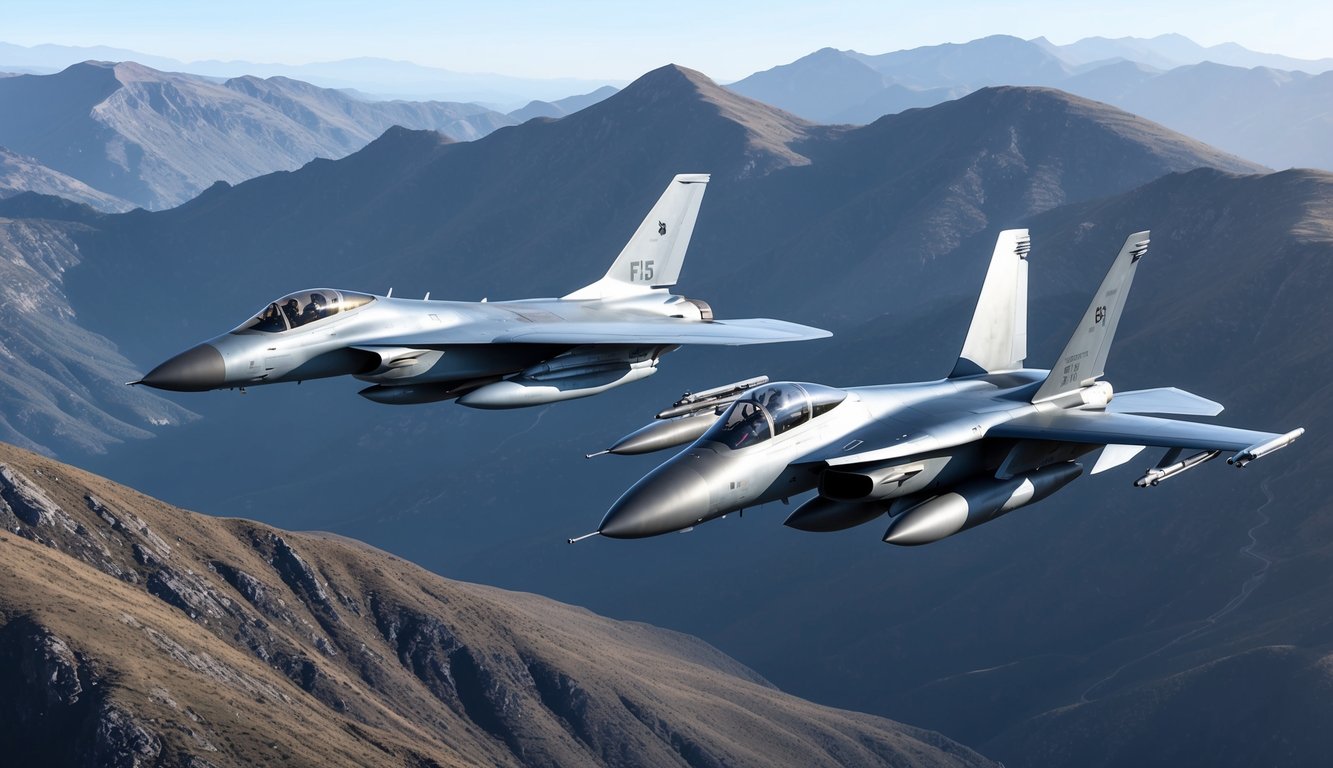
Both the F-15 Eagle and F-16 Fighting Falcon have undergone various updates and modifications since their initial service, maintaining their relevance in modern air combat scenarios.
F-15 Model Differences
The F-15 has seen numerous variants since its introduction.
The F-15C improved on the original design with more advanced avionics and increased fuel capacity.
The F-15E Strike Eagle variant stands out as a dual-role fighter optimized for air-to-air and air-to-ground missions.
This F-15E model features a strengthened airframe, added fuel capacity, and a dedicated Weapon Systems Officer seat, enabling it to carry various precision-guided munitions for enhanced versatility in combat.
More recent updates include the F-15EX Eagle II, which incorporates advanced electronic warfare capabilities and can carry hypersonic armaments, ensuring the F-15 remains competitive in the future.
F-16 Variations and Upgrades
The F-16 has also undergone extensive upgrades throughout its lifespan.
Earlier variants focused predominantly on air-to-air combat, while later models like the F-16C/D integrated enhanced avionics and extended multirole capabilities.
Notable advancements in modern F-16 versions include the F-16V, or Viper, which features AESA radar, updated mission computers, and enhanced electronic warfare systems.
Block 70/72 F-16s include these improvements along with structural upgrades aimed at prolonging service life.
Such enhancements enable the F-16 to remain a potent contender in contemporary air combat, regardless of age.
Economic Aspects
The economic profiles of the F-15 and F-16 illustrate significant differences that are crucial in procurement decisions and life-cycle costs for air forces worldwide.
Cost Comparison and Maintenance
When evaluating the F-15 and F-16, the F-16 generally emerges as the more cost-effective option.
Its lower initial unit cost makes it appealing for air forces with more stringent budgets, and its single-engine design contributes to lower operational costs by requiring less fuel and fewer parts than the twin-engine F-15.
Maintenance is another critical element; the simpler design of the F-16 translates to more straightforward maintenance procedures and lower service costs, yielding considerable savings over the aircraft’s lifespan.
However, the F-15’s higher price can translate into economic advantages.
Its robust construction and powerful engines often lead to longer service life, which can counterbalance the initial cost difference over time.
Regarding operations, the F-16’s versatility enables the completion of a broader range of missions with cost-efficiency, potentially yielding better value for diverse combat conditions.
Operational Considerations
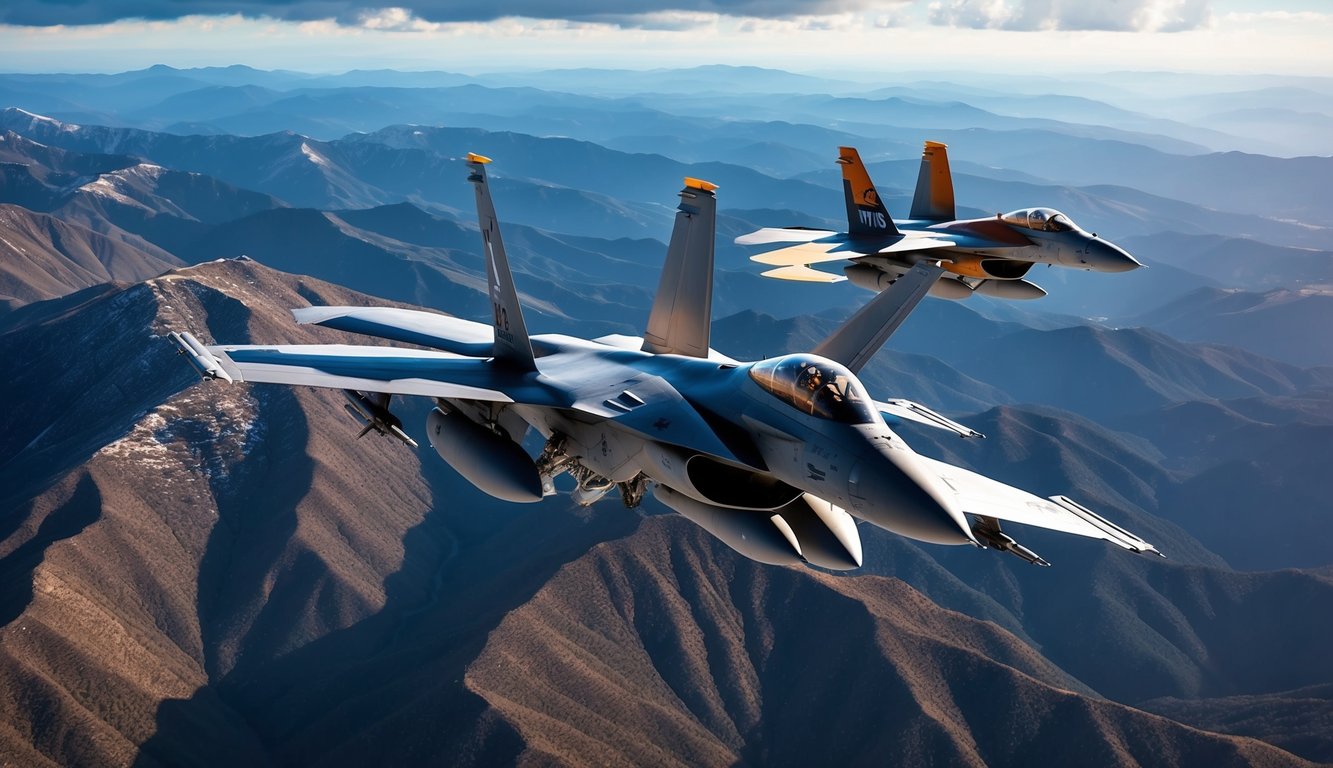
The F-15 and F-16 significantly differ in pilot interfaces and safety features, affecting training requirements and mission readiness for air forces operating these aircraft.
Pilot Experience and Interface
The F-15 cockpit provides a more spacious and information-rich environment, featuring multiple displays and controls to give comprehensive situational awareness.
In contrast, the F-16 cockpit is more compact and features a side-stick controller along with a single multi-function display.
The F-16’s fly-by-wire system delivers a high level of responsiveness, providing a unique “seat of the pants” feel that some pilots favor.
While the F-15 offers traditional controls that give more direct feedback.
Both aircraft utilize advanced avionics; however, the F-16’s systems are more integrated, thus reducing pilot workload during demanding missions.
Safety and Reliability
In terms of engine reliability, the twin-engine design of the F-15 affords an advantage; if one engine fails, the pilot can still return safely.
Conversely, the F-16’s single-engine setup poses greater risks during engine failures.
The larger airframe of the F-15 provides greater resistance to battle damage, decreasing the potential for loss should it be struck.
However, the F-16’s smaller size makes it more challenging for adversaries to target effectively.
Maintenance-wise, the F-16 is noted for its ease of service.
Its modular construction allows for quicker part replacements compared to the F-15, which, although requiring more intensive maintenance, boasts robust engineering for operating in severe conditions.
Global Impact and Deployment
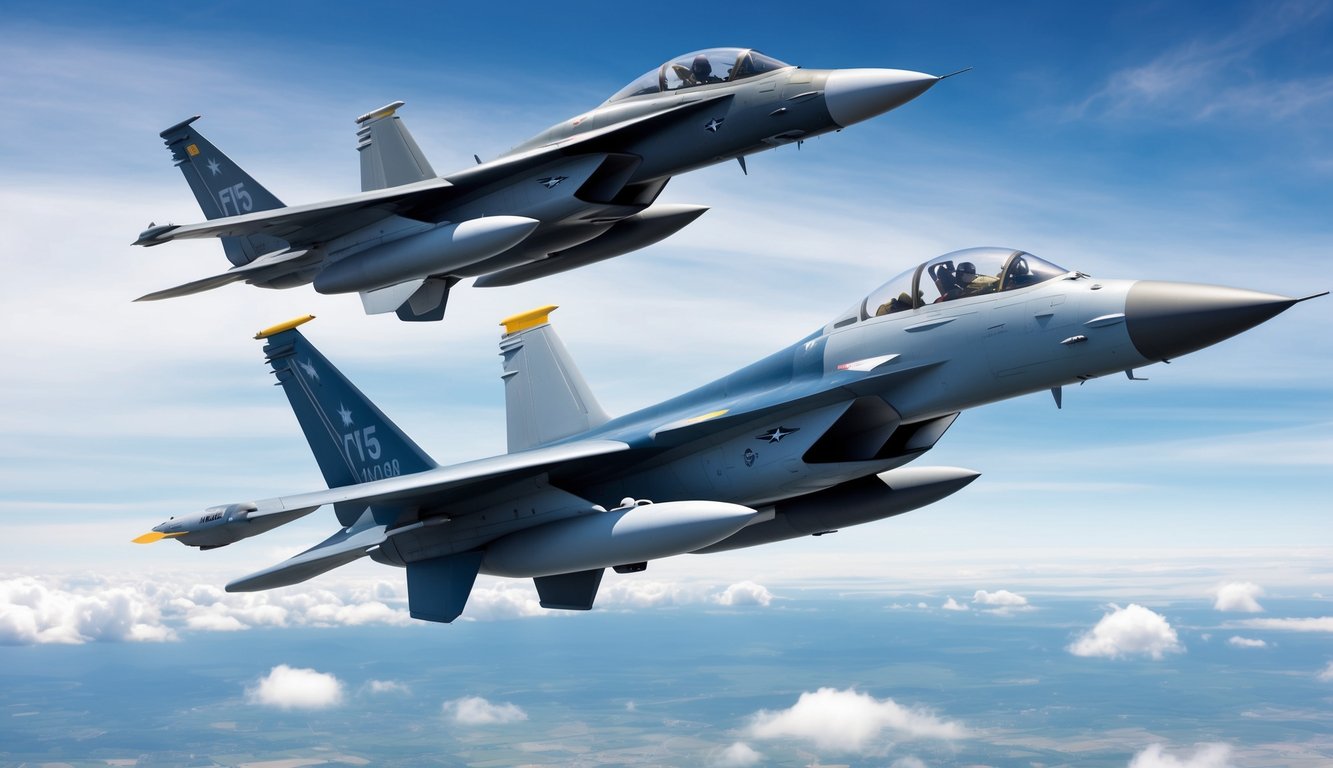
The impact of the F-15 and F-16 on global military operations and alliances has been profound, shaping airpower strategies and influencing geopolitical relationships globally.
F-15’s Role in International Security
The F-15 Eagle is a vital element of air superiority for the U.S. and its allies.
It has been deployed in numerous conflicts, including the Gulf War and recent Middle Eastern operations.
With a remarkable combat record, the F-15 has become a valuable asset for nations seeking to enhance their air defense strategies.
Countries like Japan, Saudi Arabia, and Israel include the F-15 in their air forces, which bolsters military collaborations and standardizes strategic tactics among allied nations.
The F-15’s long-range abilities and robust radar systems make it ideal for monitoring extensive airspaces and deterring possible threats.
F-16’s Presence in NATO and Beyond
The F-16 Fighting Falcon stands as a symbol of NATO’s collective military power.
You can find these versatile fighters operating over many European countries as a unifying presence within the alliance.
Their affordability and adaptability have made them appealing to smaller nations aiming to modernize their air capabilities.
Beyond NATO, the F-16 has been adopted by countries such as Israel, Egypt, and South Korea.
Its multirole capabilities enable it to undertake a diverse array of missions, from air-to-air engagements to precise ground strikes.
The recent decision to supply F-16s to Ukraine showcases the aircraft’s ongoing significance in modern warfare and its impact on international relations.
Frequently Asked Questions
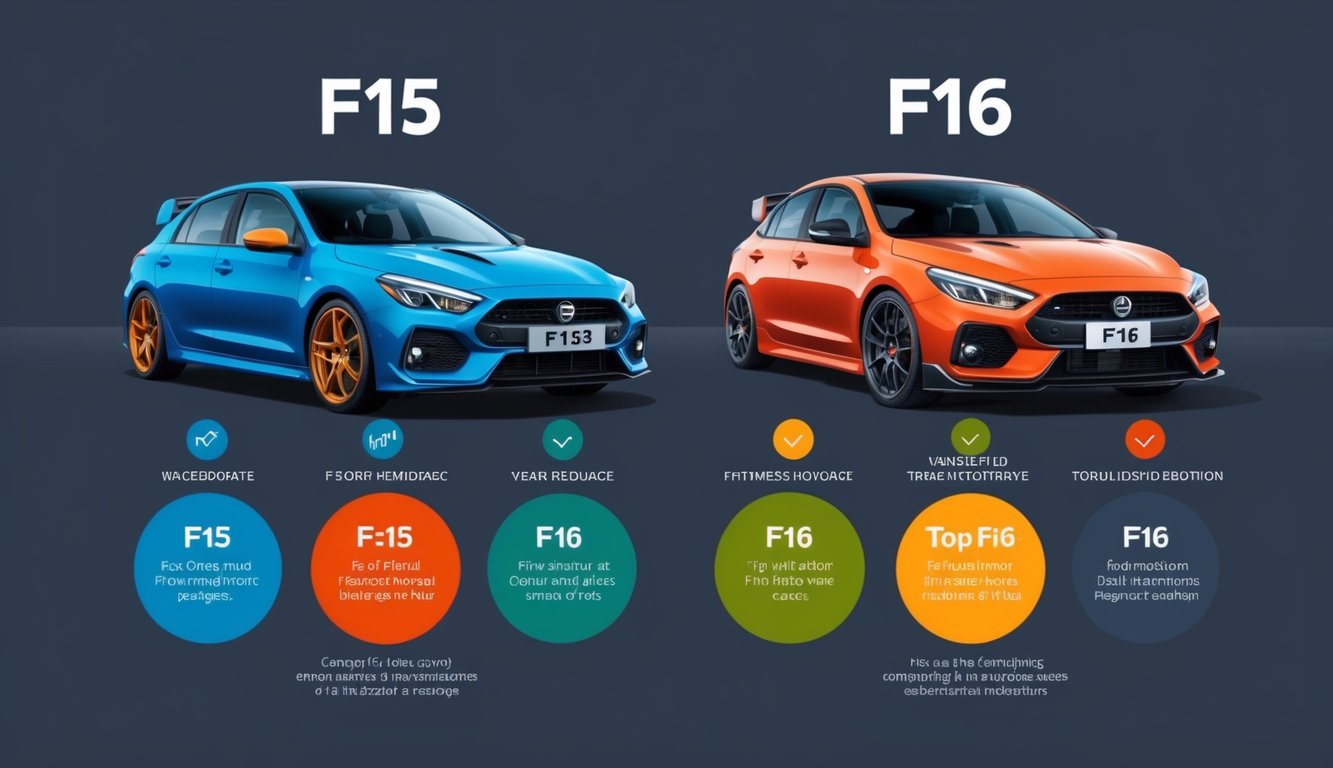
Both the F-15 Eagle and F-16 Fighting Falcon are iconic fighter jets, each possessing distinct strengths and capabilities.
Let’s take a closer look at their key differences and roles in various combat scenarios.
What are the major differences between the F-15 and F-16’s combat capabilities?
The F-15 stands out in air superiority roles due to its robust twin engines and advanced radar systems.
It has the ability to carry a heavier payload and operate at greater altitudes.
In contrast, the F-16 is designed for agility and versatility.
It can effectively perform both air-to-air and air-to-ground missions, creating a balanced combination of speed and maneuverability.
Can the F-15 Eagle outperform the F-16 Fighting Falcon in a dogfight scenario?
While the F-15 boasts superior speed and acceleration, the F-16 has the upper hand in close-range dogfights due to its enhanced agility and fly-by-wire controls.
The Falcon can execute tight turns and high-G maneuvers more effectively.
The F-15, although less maneuverable, compensates with its robust power and speed, enabling quick energy recovery following maneuvers.
What roles are the F-15 and F-16 designed to fulfill within the US Air Force?
The F-15 primarily functions as an air superiority fighter, tasked with establishing and maintaining control over the airspace.
Its strengths lie in beyond-visual-range engagements and intercepting enemy aircraft.
The F-16 serves as a multirole fighter, adept at both air-to-air combat and precision ground support.
Its versatility allows for a wide range of operational scenarios.
Which aircraft has the advantage in terms of agility and maneuverability, the F-15 or the F-16?
The F-16 clearly excels in agility and maneuverability, thanks to its lighter weight, aerodynamic design, and high-tech flight control systems that enable quick directional changes and precise handling.
While the F-15 is less agile, it compensates with strength and speed, maintaining energy during vertical maneuvers more effectively than the F-16.
How does the technology and avionics compare between the F-15 Eagle and the F-16 Fighting Falcon?
Over the years, both aircraft have received extensive upgrades.
Generally, the F-15 features superior radar and longer-range sensors, making it more suited for air superiority missions.
In contrast, the F-16’s avionics are tailored for its multirole capabilities, often incorporating modern cockpit designs and integrated systems for efficiently engaging both air and surface targets.
In terms of mission versatility, how do the F-15 and F-16 compete with each other?
The F-16 showcases greater mission versatility, thanks to its multirole structure.
It can adeptly transition between air-to-air engagements and ground attack operations.
The F-15, although tailored for air superiority, has evolved through variants like the F-15E Strike Eagle to enhance its ground attack abilities.
Nevertheless, it remains more specialized compared to the adaptable F-16.

